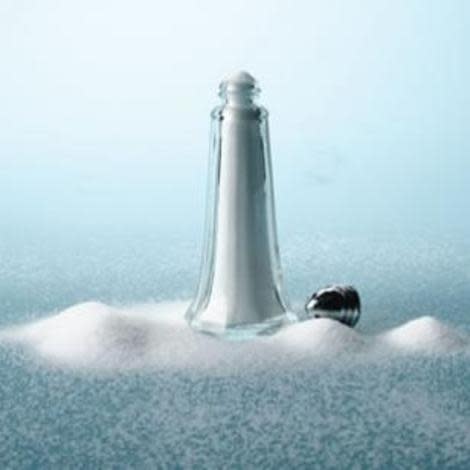How Not to Overdose on Salt

By Brierley Wright, M.S., R.D., Nutrition Editor, EatingWell Magazine
Limiting sodium is important for healthy blood pressure and overall heart health. Yet most of us consume, on average, 3,400 milligrams of sodium each day. That's much more than the daily 2,300 mg recommended limit put out in the 2010 USDA Dietary Guidelines. (If that sounds like a lot to you, keep in mind it's the equivalent of just 1 teaspoon of table salt.)
Don't Miss: 6 Easy Ways to Cut Salt in Your Diet
Adults who are 51-plus and those of any age who are African-American or have high blood pressure, diabetes or chronic kidney disease should limit their sodium even more--to just 1,500 mg daily.
How can such a controlled diet not taste like cardboard? The secret is to use wholesome, healthy ingredients that are inherently delicious and enhance flavor with herbs and spices rather than loads of salt. To help you keep your sodium intake in check, we at EatingWell have developed this one-day meal plan--which clocks in at just under 2,000 calories and 1,500 mg of sodium. And be sure to read the shopping tips so you can sleuth out lower-sodium versions of packaged foods that are notorious salt offenders. (Here are 8 great ways to lower your blood pressure naturally, sodium aside.)
Don't Miss: What Does a 2,000-Calorie Day Look Like?
Here's your one-day meal plan:
Breakfast
2 oat waffles (139 cal, 270 mg sodium)
3/4 cup strawberries (40 cal, 1 mg sodium)
6 oz. nonfat plain Greek yogurt (100 cal, 70 mg sodium)
1 medium banana (105 cal, 1 mg sodium)
1/2 cup orange juice (61 cal, 3 mg sodium)
Total: 445 calories, 345 mg sodium
Morning Snack
2 prunes (46 cal, 0 mg sodium)
12 unsalted dry-roasted almonds (103 cal, 0 mg sodium)
Total: 149 calories, 0 mg sodium
Lunch
Vegetable Sandwich (361 cal, 419 mg sodium)
1 oz. low-fat Swiss cheese (49 cal, 73 mg sodium)
3 tomato slices (11 cal, 3 mg sodium)
1/2 avocado (114 cal, 5 mg sodium)
1 Tbsp. cholesterol-free mayonnaise (50 cal, 120 mg sodium)
2 slices multigrain bread (138 cal, 218 mg sodium)
1 pear (103 cal, 2 mg sodium)
Total: 465 calories, 421 mg sodium
Afternoon Snack
1 Tbsp. unsalted creamy peanut butter (94 cal, 3 mg sodium)
2 brown-rice cakes (70 cal, 60 mg sodium)
Total: 164 calories, 63 mg sodium
Dinner
White Bean Soup (Fassoulatha) (258 cal, 326 mg sodium)
1 whole-wheat roll (74 cal, 112 mg sodium)
Salad (300 cal, 90 mg sodium)
2 cups mixed salad greens (18 cal, 28 mg sodium)
12 cherry tomatoes (37 cal, 10 mg sodium)
1 cup sliced cucumber (14 cal, 2 mg sodium)
3 Tbsp. walnuts (147 cal, 1 mg sodium)
1 Tbsp. Honey-Mustard Vinaigrette (84 cal, 49 mg sodium)
Total: 632 calories, 528 mg sodium
Evening Snack
1/2 cup 1% cottage cheese (no salt added) (81 cal, 15 mg sodium)
3/4 cup fresh pineapple (62 cal, 1 mg sodium)
Total: 143 calories, 16 mg sodium
Daily Total: 1,997 calories, 1,373 mg sodium
Keeping sodium under a cap of 1,500 mg of sodium per day requires some shopping savvy. It's always worth your while to look for "unsalted," "no salt added" or "low-sodium" versions of products (think: peanut butter, cottage cheese, canned soups, etc.). But because the sodium content of other packaged foods isn't always as obvious, always compare brands. Here are a few helpful hints to guide you through the aisles:
✓ Breads and cereals: Most store-bought breads, including rolls, pita bread and regular sandwich slices, have a significant amount of salt added to them. Compare nutrition information when choosing.
✓ Cheeses: Many cheeses, including Cheddar, feta and Parmesan, are high in sodium--which is one reason you'll see Swiss, a cheese that's naturally lower in sodium, in this meal plan. If you'd rather use another cheese instead of Swiss, consider that you're likely adding sodium.
✓ Canned beans: Look for ones labeled "no- sodium" or "low-sodium." (These terms are regulated by the FDA and mean less than 5 mg and 140 mg per serving, respectively.) Rinsing beans before you use them can remove up to 35 percent of the excess sodium.
How do you keep your sodium intake in check?
By Brierley Wright, M.S., R.D.

Brierley's interest in nutrition and food come together in her position as nutrition editor at EatingWell. Brierley holds a master's degree in Nutrition Communication from the Friedman School of Nutrition Science and Policy at Tufts University. A Registered Dietitian, she completed her undergraduate degree at the University of Vermont.
Related Links from EatingWell:
